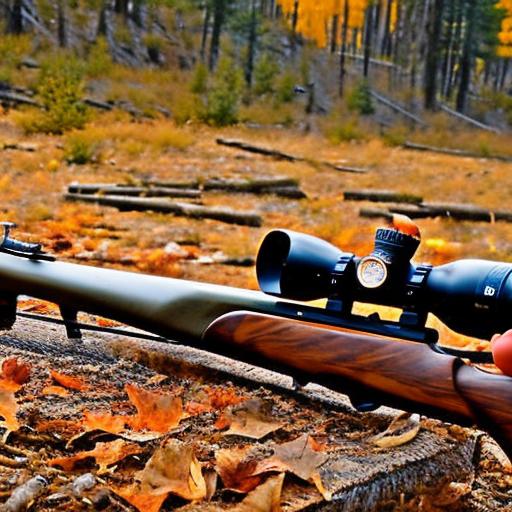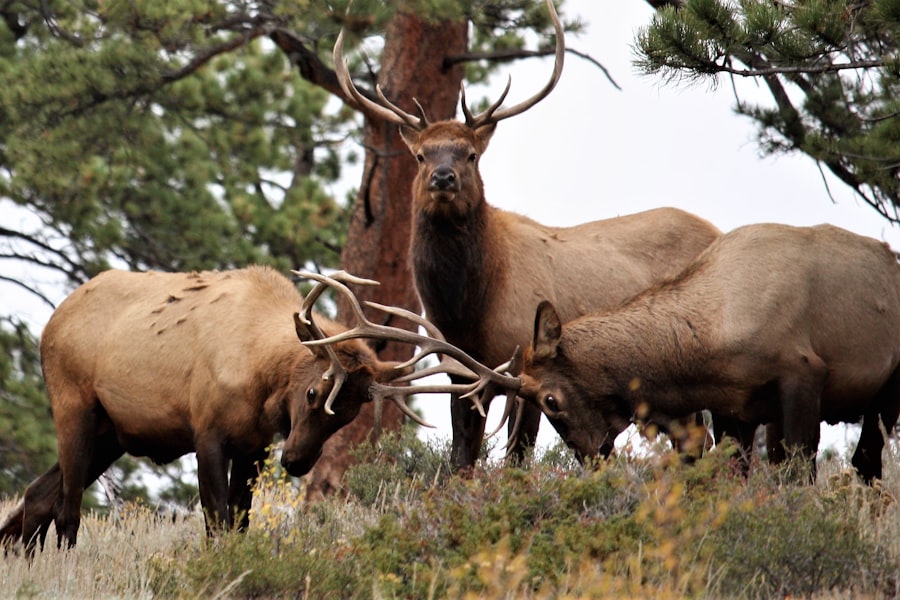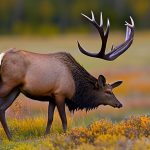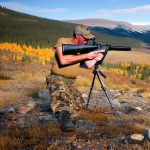Your cart is currently empty!

Taking on the Challenge: Elk Hunting with a .308 Rifle

Elk hunting with a .308 rifle is a popular activity among hunters for several reasons. The .308 rifle is known for its versatility and accuracy, making it a suitable choice for taking down large game like elk. Elk hunting itself is an exhilarating and challenging experience that tests the skills and patience of hunters. It requires careful planning, knowledge of elk behavior and habitat, and the right gear and equipment. In this article, we will explore the various aspects of elk hunting with a .308 rifle, from understanding elk behavior to choosing the right ammunition and gear, to preparing physically and mentally for the hunt.
Key Takeaways
- Elk hunting with a .308 rifle requires knowledge of elk behavior and habitat.
- Choosing the right .308 rifle and ammunition is crucial for a successful hunt.
- Essential gear and equipment for elk hunting includes a good pair of boots and a reliable backpack.
- Preparing physically and mentally for the hunt is important for a successful and safe experience.
- Field dressing and processing elk meat requires proper technique and equipment.
Understanding Elk Behavior and Habitat
Elk are majestic creatures that inhabit various regions across North America, including the Rocky Mountains, the Pacific Northwest, and parts of Canada. Understanding their behavior and habitat is crucial for a successful hunt. Elk are social animals that live in herds, typically consisting of cows (females), calves, and bulls (males). During the hunting season, bulls can be found in bachelor groups or alone, while cows and calves tend to stay together.
Elk prefer habitats with a mix of open meadows, forests, and mountains. They are grazers and feed on grasses, shrubs, and other vegetation. When scouting for elk before the hunt, look for signs such as tracks, droppings, rubs on trees, and wallows (mud pits created by elk). Pay attention to their feeding patterns and bedding areas to increase your chances of finding them during the hunt.
Choosing the Right .308 Rifle for Elk Hunting
When it comes to choosing a .308 rifle for elk hunting, there are several factors to consider. The most important factor is the rifle’s accuracy and stopping power. Elk are large animals that require a well-placed shot to bring them down ethically. The .308 rifle is known for its accuracy and ability to deliver sufficient energy to take down an elk.
Another factor to consider is the weight and maneuverability of the rifle. Elk hunting often involves long hikes and traversing rugged terrain, so a lightweight and compact rifle can be advantageous. Additionally, consider the rifle’s recoil and your ability to handle it comfortably. A heavy recoil can affect your accuracy and overall shooting experience.
Some popular .308 rifles for elk hunting include the Remington 700, Winchester Model 70, and Tikka T3x. These rifles are known for their reliability, accuracy, and durability. It is important to handle and test different rifles before making a decision to ensure that it fits your preferences and shooting style.
The Importance of Proper Ammunition
| Metrics | Importance |
|---|---|
| Accuracy | Proper ammunition ensures accuracy in shooting, reducing the risk of missing the target and causing harm to unintended targets. |
| Reliability | Using the right ammunition ensures the reliability of the firearm, reducing the risk of malfunctions and misfires. |
| Effectiveness | The right ammunition can make a significant difference in the effectiveness of the shot, especially in hunting or self-defense situations. |
| Safety | Using the proper ammunition reduces the risk of accidents and injuries, both to the shooter and those around them. |
| Legal Compliance | Using the correct ammunition is necessary to comply with local laws and regulations, avoiding legal consequences. |
Choosing the right ammunition for your .308 rifle is crucial for a successful elk hunt. The ammunition should have enough stopping power to penetrate the elk’s thick hide and reach vital organs. It is recommended to use premium bullets designed specifically for big game hunting.
For elk hunting with a .308 rifle, popular ammunition choices include the Federal Premium Trophy Copper, Hornady Superformance SST, and Winchester Ballistic Silvertip. These bullets are known for their high muzzle velocity, controlled expansion, and deep penetration.
When choosing ammunition, consider factors such as bullet weight, bullet type (e.g., soft point, hollow point), and muzzle velocity. It is important to select ammunition that is suitable for your rifle’s barrel twist rate and intended shooting distance. Consult with experienced hunters or firearms experts for guidance on choosing the right ammunition for your specific setup.
Essential Gear and Equipment for Elk Hunting
Having the right gear and equipment is essential for a successful elk hunt. Here are some must-have items:
1. Binoculars: A good pair of binoculars will help you spot elk from a distance and assess their size and behavior.
2. Range finder: A range finder will help you accurately determine the distance between you and the elk, allowing for more precise shots.
3. Backpack: A durable and comfortable backpack is essential for carrying your gear, water, food, and other essentials during the hunt.
4. Clothing: Dress in layers to accommodate changing weather conditions. Opt for moisture-wicking and scent-blocking clothing to minimize your presence.
5. Boots: Invest in a pair of sturdy and waterproof hunting boots that provide ankle support and traction on various terrains.
6. Game bags: Game bags are used to transport the meat after a successful hunt. They should be breathable and durable to preserve the meat.
7. Knife: A sharp and reliable knife is necessary for field dressing and processing the elk meat.
8. Calls: Elk calls, such as bugle tubes and cow calls, can be used to attract elk or communicate with them during the hunt.
When packing for the hunt, prioritize lightweight and compact gear to minimize the weight you have to carry. It is also important to familiarize yourself with your gear before the hunt to ensure that everything is in working order.
Preparing Physically and Mentally for the Hunt

Elk hunting requires physical stamina and mental fortitude. Before embarking on an elk hunt, it is important to prepare yourself physically and mentally.
Physical preparation should include cardiovascular exercises to improve endurance, strength training to build muscle, and flexibility exercises to prevent injuries. Incorporate activities such as hiking, running, weightlifting, and yoga into your fitness routine. Additionally, practice shooting your rifle regularly to improve your accuracy and shooting skills.
Mental preparation is equally important. Elk hunting can be physically demanding and mentally challenging, requiring patience, focus, and perseverance. Practice mindfulness techniques such as meditation or visualization to improve your mental clarity and concentration. Familiarize yourself with elk behavior and hunting strategies through books, videos, or by joining hunting forums and communities.
Strategies for Tracking and Stalking Elk
Tracking and stalking elk requires a combination of patience, stealth, and knowledge of their behavior. Here are some tips to improve your tracking and stalking skills:
1. Use binoculars: Scan the landscape with binoculars to spot elk from a distance. Look for movement, shapes, or any signs of elk activity.
2. Move slowly and quietly: Elk have keen senses, especially their hearing and sense of smell. Move slowly and quietly to avoid alerting them to your presence.
3. Use natural cover: Utilize natural cover such as trees, rocks, or vegetation to conceal your movements and blend into the environment.
4. Pay attention to wind direction: Elk have a strong sense of smell, so it is important to position yourself downwind from them. Use wind indicators or check the wind direction with a small bottle of powder.
5. Be patient: Elk can be elusive and may require hours or even days of tracking and stalking. Be patient and persistent in your pursuit.
Tips for Making Accurate Shots on Elk
Making accurate shots on elk is crucial for a clean and ethical kill. Here are some tips to improve your shot accuracy:
1. Practice shooting from different positions: Elk hunting often requires shooting from various positions such as standing, kneeling, or prone. Practice shooting from these positions to become comfortable and accurate.
2. Use shooting sticks or bipods: Shooting sticks or bipods provide stability and support when shooting from a standing or kneeling position.
3. Focus on shot placement: Aim for vital organs such as the heart or lungs to ensure a quick and humane kill. Practice shooting at different distances to become familiar with bullet drop and trajectory.
4. Control your breathing: Take slow, deep breaths and exhale fully before taking the shot to minimize movement and improve accuracy.
5. Follow-through: Maintain focus and follow-through after taking the shot. Keep your sights on the target until you are certain of the outcome.
Factors that can affect shot accuracy include wind, distance, bullet drop, and shooter error. It is important to practice shooting under different conditions and distances to become proficient with your rifle.
Field Dressing and Processing Elk Meat
Field dressing and processing elk meat is an important step in preserving the quality and flavor of the meat. Here are some steps to follow:
1. Field dressing: After a successful kill, begin by field dressing the elk. Make an incision from the sternum to the pelvis, being careful not to puncture any organs. Remove the internal organs, including the heart, lungs, liver, and intestines.
2. Skinning: Carefully skin the elk to remove the hide. Start from the neck and work your way down, using a sharp knife to separate the hide from the meat.
3. Quartering: Once the elk is skinned, quarter it by separating it into manageable pieces. This will make it easier to transport and process the meat.
4. Meat care: Properly care for the meat by cooling it down as quickly as possible. Hang the quarters in a cool, shaded area or use game bags to allow air circulation. Avoid exposing the meat to direct sunlight or warm temperatures.
5. Processing: When you are ready to process the meat, trim off any excess fat or connective tissue. Cut the meat into steaks, roasts, or ground meat according to your preferences.
6. Freezing: Package the processed meat in airtight freezer bags or vacuum-sealed bags. Label them with the date and contents before placing them in a freezer set at 0°F (-18°C) or below.
Reflecting on the Challenge and Rewards of Elk Hunting with a .308 Rifle
Elk hunting with a .308 rifle is a challenging and rewarding experience for many hunters. It requires a combination of physical and mental skills, knowledge of elk behavior, and the right gear and equipment. The challenge of tracking and stalking elk, making accurate shots, and successfully harvesting an animal is what draws many hunters to this pursuit.
The rewards of elk hunting go beyond the thrill of the hunt. It provides an opportunity to connect with nature, test one’s skills and abilities, and gain a deeper appreciation for wildlife and conservation. Additionally, elk meat is highly nutritious and delicious, making it a valuable reward for a successful hunt.
In conclusion, elk hunting with a .308 rifle is an exciting and fulfilling endeavor. By understanding elk behavior, choosing the right gear and ammunition, and preparing physically and mentally, hunters can increase their chances of a successful hunt. The challenge and rewards of elk hunting make it a popular activity among hunters who seek adventure, connection with nature, and the satisfaction of providing food for themselves and their families. So grab your .308 rifle, pack your gear, and embark on an unforgettable elk hunting experience.
If you’re an avid elk hunter looking for the perfect rifle, you may want to consider the .308 caliber. This versatile cartridge is known for its accuracy and stopping power, making it a popular choice among hunters. In fact, there’s an interesting article on Old Oak Syndicate that discusses the benefits of using a .308 for elk hunting. The article explores the ballistics of the cartridge and provides valuable insights on how to maximize your success in the field. Check it out here to learn more about elk hunting with a .308.
FAQs
What is elk hunting?
Elk hunting is the act of pursuing and killing elk for sport or food.
What is a .308 rifle?
A .308 rifle is a type of firearm that fires a .308 Winchester cartridge. It is commonly used for hunting big game animals like elk.
Is a .308 rifle suitable for elk hunting?
Yes, a .308 rifle is suitable for elk hunting. It has enough power and accuracy to take down an elk at reasonable distances.
What are the advantages of using a .308 rifle for elk hunting?
The advantages of using a .308 rifle for elk hunting include its versatility, accuracy, and availability of ammunition.
What are the disadvantages of using a .308 rifle for elk hunting?
The disadvantages of using a .308 rifle for elk hunting include its limited range and stopping power compared to larger calibers.
What is the best time of year to hunt elk?
The best time of year to hunt elk varies depending on the location and climate. Generally, the fall season is the most popular time for elk hunting.
What are some tips for elk hunting with a .308 rifle?
Some tips for elk hunting with a .308 rifle include practicing shooting at various distances, using high-quality ammunition, and scouting the area beforehand to locate elk.

Herb has been a longtime lover of the outdoors. Whether it be hunting, camping, fishing or just getting outside to reset. Proud father and animal lover. Bourbon anyone?

by
Tags:
Comments

Categories
- Big Game Hunting (301)
- Deer (202)
- Reviews (3)
- Shooting (16)
- Slingshot (1)
- Small Game Hunting (42)
- Upland Hunting (126)
- Waterfowl Hunting (3)





Leave a Reply